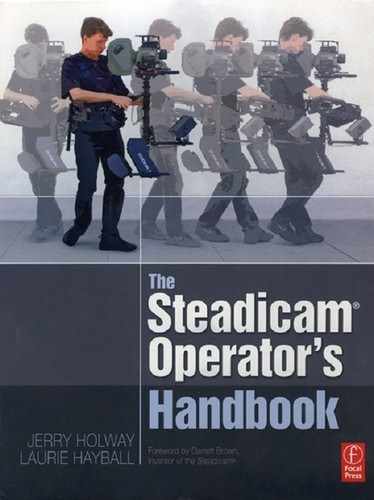Using grips wisely
to guide, to build, to rig
Traditionally, grips move the camera around, build platforms and rigs for the camera and the lights, and take on just about any other task required by the DP. They are extremely useful on set and extremely useful to Steadicam operators.

Grips guide us, adapt vehicles for our use, keep us safe on cranes, push us around on dollies, hump the rig back to number one, build platforms, ramps, and stairs, hold flags for the wind, operate half the Buddycam, catch us when we trip, fend off unruly fans in concerts, and make themselves useful in thousands of ways. Without grips, our operating would be severely limited and a lot less safe.
Grips are a hardy lot. They don't need a lot of attention — just your respect and clear communication of your needs and concerns. They generally don't need to be micro-managed; they know how to build things and have many tricks and methods for creating whatever you need.
You can make a grip's life easier (and therefore, your life) by asking for flags, stairs, ramps, and the like as early as possible. Grips usually have a lot to do, and adding your needs into the mix is not often easy, even on big productions. Don't assume they are free to work for you. Production managers often ask the Steadicam operator to work with the existing camera assistants; rarely are extra grips hired because a Steadicam operator is coming to set.
You should know how high and low you can get a lens relative to the socket block — in both high and low modes — so the grips can construct a vehicle mount correctly the first time around. If you've got the vehicle mount adaptor or other specialized equipment, get it to the grips early. Make yourself available to the grips as they build things for you; check it out and test it for safety and functionality as they proceed. For instance, if it's a specialized vehicle mount for an ATV, sit in it often as it is being built checking for clearances and interference, sturdiness, etc.

Using grips as guides
A grip can help you get through a set and keep you out of harm's way. However, do not rely on grips to lead you through a set.
You should know the path for the camera and find ways to make it happen without the grip. The grip is there to give you the confidence to move as you believe you must and to get you back on path if your methods fail.
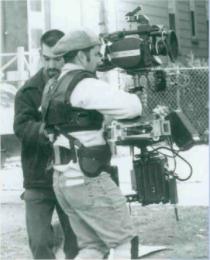
Grips should move you around by poking you in the ribs, suggesting that you take a different path. Pushing you may feel like a strange variant of gravity, which we are taught to resist. Verbal clues — “You're gelling quite close to the cliff!” — are hard to process in the heat of production. You might wonder if those words are meant for you. A good poke in the ribs is unmistakable: it's for you and it tells you exactly how to respond.
If you fall, it will be too late for the grip to reach out and grab you. When there's a danger of falling, such as on stairs, backing up over curbs, or near the old cliff, then the grip must be grabbing the vest at all times. The grip's hold should exert no pressure or influence on the vest. I like the feel of the grip's hand under the vest against my back: it gives me extra confidence to proceed at those dangerous moments.
Stairs are tricky for spotting. Most of the time I do not use a grip on the stairs. If the grip is below me, there's a danger of flipping over him if I fall down the stairs. If he's above me, there's a danger of him falling on me. Either above or below me, he must stay out of the shot, have a hand on the vest, and stay close without getting in the way. If the stairs are visible and regular, with a constant pitch and tread, then I won't use a grip to spot me.
If the stairs aren't regular or visible, or they are steep or the pace is outrageous, I might have a grip spot me. If I'm going up a lot of stairs,I might consider getting a grip to help carry me up the stairs with a lifting hand under the vest.
Where the grip should grab your vest:


Grip lifts and pushes
Sometimes the rig is heavy and the road is long and steep.
Grips can be amazingly useful, pushing you up hills, or grabbing your vest as your legs turn to jelly. If they just take a few pounds off your load going uphill, operating a shot can be delightful instead of disastrous.
Get the grip to push you low on your back, near your hips (so he doesn't push you over) or with a hand under the vest, lifting the vest as you amble along. Practice to find what works for you in the particular situation, and have some way of communicating that you need more or less help from the grip. Swatting at him is not recommended.
Building stairs and ramps

This is a steep ramp! The ideal is to build a manageable slope that you won't have to worry about whiie operating.
A useful accessory for your kit is a set of wooden stairs that can be placed just where you need them to get that mini-crane move. It's nice to have two, four, and six step versions pre-built and ready to deploy at a moment's notice. You can make this yourself, or if there's time on a big production, the grips can make it for you.
The top step should be a platform at least 18 inches deep. Nicely sanded holes in the wood for the grips to grab will be greatly appreciated. If you want to get fancy, the set can be designed to nest so that the two step version becomes the first two steps of the four stepper, and the two and four steppers become the first four steps of the big one.

Consider adding these accessories for your humble stair set:
- As the ground is rarely level where you place the box, four ladder-leveling feet can be quite handy.
- Add some small wheels to the six-stepper so the grips can roll it from place to place.
- Bolt your stairs to a big western dolly, add a handrail, and you have a very interesting low-tech contraption.
Gripology
Grips are great for working through problems. On the movie Sudden Death, I was asked to rapidly travel up and down some very steep (about 45°) industrial stairs above a hockey rink. They wanted me to both precede and follow the action. The low and narrow ironwork around the stairs prevented me from carrying the rig, so I had to ride something, but what?
Sudden Death 1:37:14
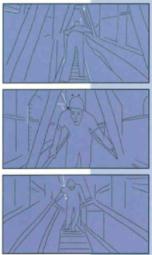
The grips built an amazing little sled with skateboard wheels and hid the track - two long pipes - in the industrial structure of the stairwell. They also constructed an angled hard mount for the tiny sled - all and all, there was just barely enough clearance in all directions to make the trick work.
To move the sled, they ran a rope from the sled up the stairs, through some pulleys out over the center of the hockey rink and down to another pulley in the seats. Eight hardy grips grabbed the free end of the rope and either hauled me up or let me fly down the stairs. These grips were completely out of sight, so they used walkie-talkies to communicate with the key grip next to me on the stairs. With lots of marks and a few prayers, we got the shots.
Buddycam
When Garrett invented the JR in 1987, the idea of the Buddycam was also born.
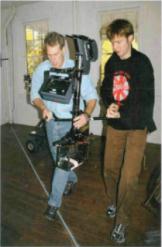
We traditionally use an arm and vest to lift the combined weight of the camera, sled, and monitor. But if we had a buddy to share the load, we could operate a heavy Steadicam just like we operate a JR, without an arm and a vest.
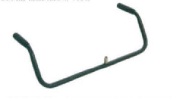

The Buddycam is a handlebar-like device that mates with the gimbal. The handles are designed so that a straight line between them passes through the post, slightly above the pan bearing. When you and your buddy lift the Buddycam, it feels like there is a piece of string stretched between the handles and the sled.
Remember, the gimbal still isolates the angle of lift from the sled, so the grip doesn't have to be in perfect sync with you as you move about the set. The boom range is from as low to as high as you and your partner can lift, and you can bend over while operating (ugh!), work in tight spaces, climb stairs, etc.
In low mode, the lens can be anywhere from on the deck to over 6 feet in the air. Super low mode to high mode shots are a snap. Perfectly vertical moves can even be done in tight spaces like interior hallways, and they can easily be combined with pans — even with whip pans if the grip can duck out of the way!
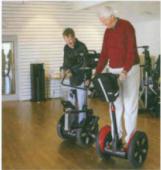
Madness! 6ft boom range, 20mph!! Many ideas and gadgets get tested at workshops.
Running through tall grass is easy, as is climbing a steep hill. For really high hills, have two or three pairs of grips to do the grunt work. They pass the Buddycam off when they get tired (this is pretty easy). You stay between the grips, lift nothing, and operate.
With a wider set of handles, some truly amazing shots flying over tables (or heads!) are possible.
Here's an idea for making a shot with a large vertical component in a very tight space. Attach the ends of a Buddycam to a couple of ropes in some sort of rig, and you can have a flying, weightless camera. All you have to do is climb a ladder next to the Buddycam and you have an amazing crane shot. If the wires can be detached, the shot can even continue beyond the lift!
When words just won't do
Sometimes words are completely useless. I was working on the Italian movie Occhio Pinocchio, part of which was shot in Texas. Everyone would talk in Italian (I understood basically none of it) and then want to roll the camera. Faccia presto, per favore. I'd say I had no clue what to do - their words had no meaning for me. Stia tranquillo! Motorie! So we'd shoot the rehearsal, and I'd quickly be framing an extra or a blank wall, and everybody would be yelling “Jerry, Jerry, Jerry!” which I understood. I'd smile, and they would patiently show me the action and the framing they wanted (using their hands, of course!) and I'd give them my first real version, which we could discuss (again, mostly with our hands), and move on to take due, tie, quattro, cinque.
When working up a shot, try to connect with the character and the story. Listening, watching, and trying to connect emotionally are all extremely important for good operating. However, if in your enthusiasm, you tell others on set about some magical connection you are feeling with the character and how the shot reflects this great connection, you will probably meet with a lot of blank stares, even from your best friends.
